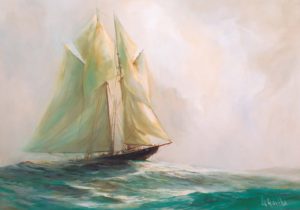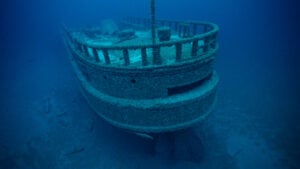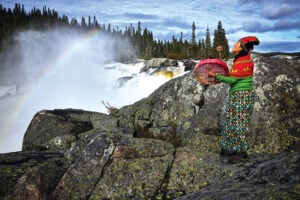
History
Bluenose: Behind the sails
The symbolism of the iconic Canadian fishing and racing schooner Bluenose may be as relevant today as it was 100 years ago when the ship first hit the water
- 3226 words
- 13 minutes
Travel
A cruise aboard America’s oldest schooner offers a fittingly marine way to explore Maine’s coastline

“Heave!” “Ho!” “Heave!” “Ho!” Standing beside the tall ship’s main mast, my heave mate and I reach as high as we can. With a nod, we grab the sail rope, then pull hard, throwing our weight to the wind. “Heave!” Just as our knees are about to hit deck, the ho team springs into action. They haul the rope tight, away from the mast. We heave and ho, slowly unfurling the mainsail along the mast until it’s flapping in the breeze, waving goodbye to the port of Camden, Maine. Captain Garth Wells gives us a thumbs up. But when we look for a comfy spot in the sun, First Mate Brent shakes his head. “Staysail!” he yells. We start over again with sail number two.
No sooner has the Lewis R. French sailed out onto the glitter-strewn Penobscot Bay when cellphone reception cuts out. “There goes connectivity,” says one of my fellow passengers and stows his phone with a sigh. It’s hard to tell if he’s miffed at the prospect of not having access to social media during our three-day windjamming cruise, or if that’s a sigh of relief. The only wavelengths at our disposal now are the ones beneath our feet. As Camden’s white clapboard houses and tidy gardens with hydrangeas the size of apple trees blur into the background, we leave behind modern conveniences. Built in 1871, America’s oldest schooner has no electric motors, not even a winch, for hoisting sails and weighing anchor; there’s no fridge (our food and beer are kept cold in ice boxes on deck); and no clocks.
Lewis R. French is a time machine that connects myself and the 20 other passengers with old rhythms. It synchs us with the ebb and flow of daylight, with cool sea sprays and sun-warm rocks, creaking masts and twinkling stars. The tempo is laid-back enough to help cure my reluctance (not fear) of the sea. A landlubber, born and bred in the boreal forest, I’ve always preferred to sniff the salt-sprinkled air from terra firma rather than getting my feet wet. So, when Captain Wells explains to me that this boat was made for cruising from port to port with cargo — “We think of her as an 18-wheeler carrying everything from lumber to fish and Christmas trees,” he says — rather than plying the open ocean, it’s my turn to sigh with relief. Windjamming on the Gulf of Maine is like seafaring with training wheels.
As Camden’s white clapboard houses and tidy gardens with hydrangeas the size of apple trees blur into the background, we leave behind modern conveniences.
The breeze propels us forward, and soon the swell lulls us passengers into a state of relaxation. The four-person crew, however, doesn’t rest. Brent and the deckhand, Oona, are faking ropes, coiling them neatly so no one stumbles over them. In the galley below, Derek, the ship’s cook, is already developing his hero status, baking bread and making potato-leek soup using a single wood-burning stove. Captain Wells, manning the wheel, scans the horizon. A nautical chart held down with a magnifying glass is splayed beside him. I ask where we’re going. “In that direction,” he replies, pointing toward Vinalhaven, one of the biggest of the nearly 2,000 islands scattered in Penobscot Bay. That’s about as specific as he gets. “I don’t think I’ve ever ended up where I planned to go when first setting out in the morning,” he says. “You never know where the wind will take you.” This is part of what makes the trip so great. Our daily lives are largely hyper-planned, from meetings to workouts to dinner parties with friends, even a “spontaneous” beer with a buddy doesn’t happen unless it’s in the calendar. Here, we literally go with the flow.
That doesn’t mean technology is completely banished on board. Captain Wells keeps a GPS and a radar, as well as a shortwave radio for communicating with other boats, in case of an emergency. And while passengers are asked not to use cellphones for talking (some do get spotty service), silent mode is accepted. There’s even generator-powered electricity late at night to shed light in cabins and in the two heads (the two loos, one of which has a freshwater shower). And our floating National Historic Landmark comes with a yawl boat. Equipped with an engine, it can push the schooner should the wind give up.
We don’t need the yawl boat today — we’re sailing handily through the Fox Islands Thoroughfare, which separates Vinalhaven and North Haven. “North Haven is where the rich folks have their summer homes,” says Jessica, a local gal who’s taken a few days off to get out on the water. “And over there, on Vinalhaven, is where the fishermen live,” she says, eyes on pretty houses that on North Haven might classify as guest cabins, at least in terms of size. The fishermen are descendants of the crews that made Penobscot Bay one of the first commercial lobster grounds in Maine.

We drop anchor at Hells Half Acre, close to Devil Island and The Shivers. I prefer not to imagine how those places might have gotten their names, focusing instead on the promise of an all-you-can-eat lobster bake. Hells Half Acre, I discover as soon as we’ve rowed there from our anchorage, is more like heaven. The beach we land on is draped with rockweed, and higher up, we step on a slab of granite, shaped by the tide to form a smooth, terraced ledge that’s perfect for hanging out and playing Frisbee. Derek barbecues red hots (Maine’s own red-hued hot dogs), hamburgers and veggie skewers over a portable grill and hands out cans of Moxie, the official state soft drink, which tastes like a mix of root beer with a splash of wintergreen, bubble gum and bitters. Garth and Oona plop lobsters and corn on the cob into a cauldron with boiling sea water, and by the time the shellfish have turned as red as the setting sun, they’re poured out on a bed of rockweed. We dig in.
If anyone thought they ate too much, the following morning presents an opportunity to burn the extra calories. It turns out getting ready to sail again takes considerable muscle power — there’s no winch, so the anchor has to be lifted manually. I raise my hand, joining three other volunteers; after gorging the previous day on Derek’s sourdough bread slathered with butter, lobster and fudge brownies, I feel I need a workout. (There’s dessert at lunch and dinner, and pre-breakfast muffins to tide early risers over from 6:30 to 8 in the morning.)
I take my place at the cranking lever, which moves like a see-saw. With four hands pushing down on either end, we start cranking, up and down, up and down. It’s heavy going, and Brent explains it’s because the anchor is lodged in mud, which offers the best holding power. “If it rests on rock, which is marked on the nautical chart, the anchor might drag across the seafloor, causing the boat to drift,” he says. Sand is not as firm as mud, and the anchor can slip above the bottom if there are waves, another cause for drifting. But mud also makes for the most triceps-busting of anchor lifting. Our arms are burning when my crank mate starts singing to keep a steady cadence. Then we compose a tune specific for the task at hand. “Cranky? Cranky? Who is cranky?” The two guys on the other end of the lever reply: “Cranky, cranky, I’m not cranky!”
We’re soon cruising along at eights knots, crossing paths with other windjammers from the eight-member fleet that makes up the Maine Windjammer Association.
We’re soon cruising along at eights knots, crossing paths with other windjammers from the eight-member fleet that makes up the Maine Windjammer Association. From my perch under the jib sail, right where the bowsprit extends from the hull, I can see vestiges of the granite quarrying that at one time was a major economic driver for the Penobscot Bay area. Blocks of granite cut by man still rest on rocky shores. The stuff hewn from Maine’s headlands and islands wasn’t just any old rock; it was monumentally good, used to build famed U.S. landmarks, including Fort Knox, the Gettysburg Monument and General Grant’s tomb, among other things. As I’m sitting at my lookout, the wind picks up in force, so I head down into the galley to warm up.
Derek is cooking — or trying to, standing with his feet wide apart to maintain balance in the rolling swell while prepping steelhead trout with pan-seared fennel and smoked basmati rice. I tell him about the granite blocks, and he nods toward a sign on a beam above his head with the number 50. “The schooner used to haul 50 tonnes of cargo, including granite,” he says and opens a hatch in the floor. He points at a bunch of bars that look like gold bars. “But these are made of lead. They’re ballast. Without them, we’d flip over.”
It feels good to be assured we will not capsize, so good, in fact, that I finally muster enough courage to ask Captain Wells if I can steer the boat. Knowing I will not cause anyone any major harm even if I screw up, I take the helm. But when Wells senses my hesitation, he tells me the ship won’t turn at the slightest motion of hands. “You need big movements, a quarter-turn of the wheel, to move the rudder and the boat,” he explains. He shows me where we’re heading, tracing a line on the nautical chart to Gilkey Harbor. Then he points at a space between two landmasses in the distance. I set as my landmark the tallest hill I can see. The Lewis R. French travels along at the speed of the wind; all I do is nudge it in the right direction. I’m navigating the good old way, and that’s when I feel it. My ship has come in.
Editor’s note
The Lewis R. French turns 150 years old in 2021. To celebrate the birthday, hop onboard for one of the three- to six-day sailings, some of which include options to kayak, hike or take in the folk music festival on Swan’s Island. To book, visit schoonerfrench.com or call 1-800-469-4635.
Seven Maine must-sees
Before or after your windjamming cruise, here’s a selection of seaside hot spots in Camden worth a visit.
The Uproot Pie Co. Don’t miss Jess Shepherd and her roving, wood-fired pizza oven, or you’ll miss out on the tastiest thin-crust pies on Maine’s central coast. Baked fresh anywhere from Camden to Rockport on Thursdays through Sundays, the pizzas come with toppings such as locally made fennel sausage and gorgonzola cheese. theuprootpieco.com
Swans Island Company What started with the goal of making “the best possible wool blankets” has at the very least resulted in the softest possible wool blankets. Made by hand from wool sheared off sheep that spend their summers roaming an island in Maine’s Penobscot Bay, the lightweight blankets have, since the company’s inception two decades ago, been accompanied by scarves and shawls. swansislandcompany.com
Long Grain Food critics have called this little restaurant, which artfully mixes Asian flavours and New England ingredients, the best Thai food in North America. The chicken wings are a favourite, but you can’t go wrong with the garlic chive rice cakes, the beef Panang curry or the house-made noodles. Once the spot re-opens for in-room dining, you’ll be able to wash it all down with a regional or imported beer from a list that spans continents and even includes some obscure craft beers from Japan. longgraincamden.com
Camden Hills State Park For endless views of Penobscot Bay — either as a preview of where you will be sailing, or as a recap of where your tall ship has just come back from — head for the top of the hill in this lush state park. You can walk up, but if you’re feeling lazy, there’s a road you can drive to the summit. There are also hiking and biking trails for land-based adventures. maine.gov
Zoot Coffee For a resolute wake-me-up, start your day with an espresso at this community-oriented café, which also serves up vegetarian fare, including muffins and cookies, to go with your caffeine fix. zootcoffee.com
Sea Bags Bring a bit of the maritime realm home with you thanks to this shop, which sells bags made from refurbished sail cloth. Some feature original lettering, while others have been printed with nautical charts, anchors or marine life motifs. There are also sturdy door mats braided from colourful lobster-trap rope. seabags.com
Boynton McKay Food Co. In the “Before Times,” this beloved all-day-breakfast spot was the place to cozy up for full-until-dinner items like crab-and-cheese-melt bialy and Wavos Rancheros (yes, that’s how it’s spelled here). While everyone’s awaiting the chance to grab a table in one of the booths, chef Brian Beggarly serves up Cold Toes Tacos and Ruckus Donuts for takeout. boynton-mckay.com
Are you passionate about Canadian geography?
You can support Canadian Geographic in 3 ways:

History
The symbolism of the iconic Canadian fishing and racing schooner Bluenose may be as relevant today as it was 100 years ago when the ship first hit the water

Exploration
Yvonne Drebert and Zach Melnick set out to make a documentary about invasive quagga mussels in the Great Lakes. Along the way, they found the wreck of what is likely the steamship Africa, last seen on a stormy October night in 1895.

People & Culture
As the climate heats up, so do talks over land ownership in the Arctic. What does Canadian Arctic Sovereignty look like as the ice melts?

Environment
In February 2021, the world was introduced to Mutehekau Shipu — also known as the Magpie River — when the people of Ekuanitshit, Que. and the regional municipality made a joint declaration granting the river legal personhood and rights. The declaration carries broad implications for the fight to protect nature across Canada and around the world.